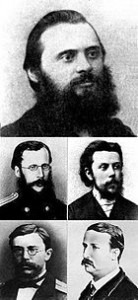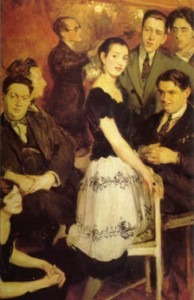
Mily Balakirev (top), César Cui (upper left), Modest Mussorgsky (upper right), Nikolai Rimsky-Korsakov (lower left), Alexander Borodin (lower right)
The Three Bs are J.S. Bach (1685-1750), Beethoven (1770-1827), and Brahms (1833-1897). In those three composers alone, we have the history of German music from the late-17th century until the very late 19th century. It is thought that the coining of the term “The Three Bs” came from yet another “B” – the conductor Hans von Bülow.
Bach: Mass in B Minor, BWV 232 (The Bach Ensemble; Joshua Rifkin, Conductor)
Beethoven: Missa Solemnis: Kyrie (Bavarian Radio Symphony Orchestra; Bernard Haitink, – Conductor
Brahms: Kyrie in G Minor, WoO 17 (Stuttgart Chamber Choir; German Chamber Philharmonic Wind Soloists; Frieder Bernius, Conductor)
Just listening to these three Kyries gives you some idea of the progress of German music over those 200 years.
The Five or The Mighty Handful are the Russian composers Mily Balakirev (1837-1910), Alexander Borodin (1833-1887), César Cui (1835-1918), Modeste Mussorgsky (1839-1881), and Nikolai Rimsky-Korsakov (1844-1908). Born within 11 years of each other, these composers are credited with creating the 19th-century Russian school of nationalist music. After decades of importing music from Europe, Russia now had its own style and music.

Le Groupe des six, 1921 painting by Jacques-Émile Blanche. In the center: pianist Marcelle Meyer. On the left, from bottom to top: Germaine Tailleferre, Darius Milhaud, Arthur Honegger, Louis Durey. On the right, standing Francis Poulenc, Jean Cocteau; and seated Georges Auric.
Rimsky-Korsakov: Russian Easter Festival, Op. 36 ((Anima Eterna Orchestra; Jos van Immerseel, cond.)
Borodin: In the Steppes of Central Asia (Anima Eterna Orchestra; Jos van Immerseel, cond.)
Mussorgsky: Pictures at an Exhibition: X. The Great Gate of Kiev (New York Philharmonic Orchestra; Leonard Bernstein, cond.)
The Six or Les Six, in French, was the school that was the only to include a woman. Composers Georges Auric (1899-1983), Louis Durey (1888-1979), Arthur Honegger (1892-1955), Darius Milhaud (1892-1974), Francis Poulenc (1899-1963), and Germaine Tailleferre (1892-1983) were names as a group by critic Henri Collet, who saw them as a change from the overwrought style of Wagner and the impressionistic style of Debussy and Ravel.
The composer Erik Satie is credited with bringing them together for a concert in 1917 in a painter friend’s studio. Satie assembled a group of composers that he named “Les nouveaux jeunes.” It was a true assembly of early 20th-century artistic talent because the walls of the studio were decorated with canvases by Picasso, Matisse, Léger, Modigliani and others. With the greatest art of the day, the concerts had the most innovative music of the day.
Tailleferre: Partita, ‘Hommage à Rameau”: III. Allegro spirituoso (Aldo Orvieto, piano; Renato Maioli, piano; Tammittam Percussion Ensemble; Guido Facchin, cond.)
Milhaud: Le Boeuf sur le toit, Op. 58 (Lille National Orchestra ; Jean-Claude Casadesus, cond.)
In these two recordings of music by two members of Les Six, you’ll quickly hear that this is much more jazz influenced than what had come before.


